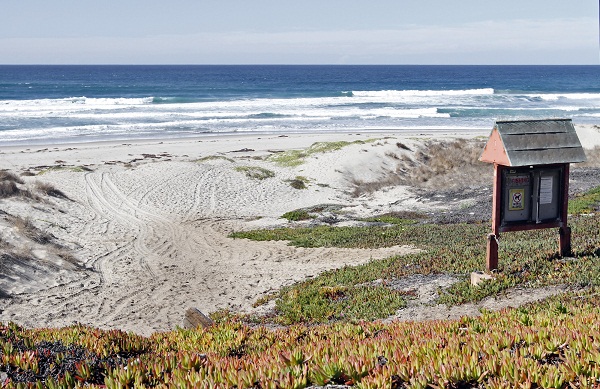Experts: Killer shark was probably great white

Tracks left by Vandenberg Air Force Base Security Force personnel responding on all-terrain vehicles to Surf Beach in Lompoc, Calif. are seen Tuesday, October 23, 2012 following a fatal shark attack. 39-year-old Francisco Javier Solorio Jr., of Orcutt, was killed while surfing at the same beach UC Santa Barbara student Lucas Ransom was fatally attacked at two years and one day prior. AP/The Santa Maria Times, Leah Thompson
LOS ANGELES — An expert has determined that a surfer was killed off California’s Central Coast by a 15- to 16-foot (4.8-meter) great white shark.
Ralph Collier of the Shark Research Committee examined the body of 39-year-old Francisco Javier Solorio Jr. of Orcutt before making the determination Wednesday.
The surfer was bitten in the upper torso in the waters off Surf Beach in Santa Barbara County on Tuesday. He died at the scene despite a friend’s efforts to save him.
“His friend ended up swimming over and pulling him from the water where he received first aid,” sheriff’s Sgt. Mark A. Williams said.
Friends said Solorio had ridden the waves there since he was a boy.
Article continues after this advertisement“He was a really good surfer,” friend Nathan Winkles told KEYT-TV in Santa Barbara.
Article continues after this advertisementThe beach, about 150 miles (240 kilometers) northwest of Los Angeles, also was the site of an October 2010 fatal attack.
Lucas Ransom, a 19-year-old student at the University of California, Santa Barbara, died when a shark nearly severed his leg as he body-boarded.
Surf Beach is near Vandenberg Air Force Base. The Air Force said Solorio was not affiliated with the base, which allows public access to some of its beaches.
All beaches on the base’s coastline were closed for at least 72 hours as a precaution, Col. Nina Armagno said.
Great white sharks are found from tropical to polar regions and are not uncommon up and down the California coast, experts said.
However, they do not attack humans as a rule, experts said.
“If white sharks were going to target humans for prey, I would never talk to any survivors,” Collier said. “Because there’s no way you or I could ever survive an attack by a 17-foot shark that weighs 4,000 pounds.”
There have been nearly 100 shark attacks in California since the 1920s, including a dozen that were fatal, according to the California Department of Fish and Game. But attacks have remained relatively rare even as the population of swimmers, divers and surfers sharing the waters has soared.
An average of 65 shark attacks happen each year around the world that typically result in two or three deaths, according to the Pew Environment Group.
Last month, warning signs were posted at Santa Barbara Harbor, about 65 miles (105 kilometers) southeast of Surf Beach, after a 14-foot (4.2-meter) great white shark was spotted by a surfer.
In July, a man escaped injury near Santa Cruz after being thrown from his kayak by a great white shark that bit through the vessel. An almost identical incident occurred off the coast of Cambria in May.
Hundreds of miles south near the coast of San Diego, a 15-foot (4.5-meter) great white shark is believed to have killed triathlete David Martin in 2008.
Great white sharks are inquisitive and use smell, vision and taste to identify objects in the water, which can be more difficult if the ocean is churned up or murky, he said.
It is likely that the shark that bit Solorio failed to identify the surfer and “struck out at this shape assuming it was a natural prey,” Collier said.
“The way it investigates is by taking a gentle bite but unfortunately, what seems like a gentle bite to a shark can cause a devastating injury to a human,” Nosal said.
Some sharks come closer to shore from around October to January because that is when some of their favorite prey — nutritious, blubber-rich seals and elephant seals — are abundant on land, said Sean Van Sommeran, executive director of the Pelagic Shark Research Foundation in Santa Cruz.
“Shark-tober is a phrase we coined,” he said.
Collier said he has seen sharks as close as 20 feet (6 meters) to beaches.
No large seal colonies are near Surf Beach, a locally popular rural area that is known for its treacherous riptides, said Robin Dunaetz, who owns a surf shop in nearby Lompoc.
Since the deadly attack two years, surfers have been aware that sharks may lurk offshore.
“They take it into consideration, like with anything” she said. “When you get on a highway you take a risk; when you get out in the water, you take a risk.”
Shark sightings appeared to have become more frequent in the past four to six years but that may simply be a result of more people being in the water, she said.
In fact, experts said humans pose more of a threat to sharks. Collier said shark populations have been decimated by fishermen, shark-fin poachers and others who have killed 60 million to 100 million sharks annually in the past decade.